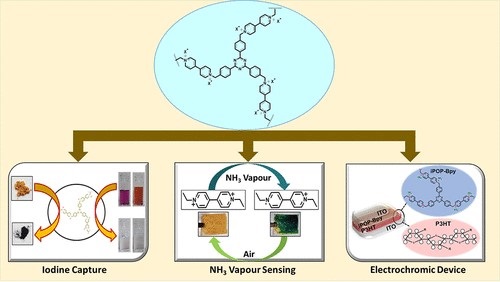
A major environmental concern related to nuclear power is the creation of radioactive wastes. In a recent collaborative study, researchers have developed a new polymer capable of absorbing hazardous chemicals and other industrial wastes.
A team of researchers from the Indian Institute of Technology (IIT) Indore; Indian Institute of Science Education and Research (IISER) Thiruvananthapuram; and IIT Roorkee introduced an ionic porous organic polymer (iPOP-Bpy) in a one-pot synthesis method.
“The synthesized polymer shows excellent efficacy in the adsorption of iodine, sensing of ammonia vapour, and solid-state device fabrication,” informs Dr Suman Mukhopadhyay, the lead researcher.
Volatile radionucleotides are among the most hazardous toxic wastes produced in nuclear power plants. The nuclear power industries and medical applications use several radioactive iodide derivatives for therapeutics. These wastes, if dumped into the environment, can cause severe radioactive contamination. Fast and efficient capture of such nucleotides is the only solution to these problems.
A major environmental concern related to nuclear power is the creation of radioactive wastes. In a recent collaborative study, researchers have developed a new polymer capable of absorbing hazardous chemicals and other industrial wastes.

“The synthesized ionic porous organic polymers work as an efficient sorbent material for the capture of iodine and iodide derivatives in vapour, organic, and water phase. Our polymeric system proved to be an excellent platform for capturing iodine in the vapour state and from water and organic solvent like hexane,” Dr Mukhopadhyay explains.
The polymer developed also acts as a rapid sensor for ammonia vapour, even at a very low concentration. For ammonia sensing the team prepared a polymeric pad by sticking the polymer in a double tape. When it was exposed to ammonia vapour, the colour instantly changed from pale yellow to deep blue.
Ammonia is used in various industrial applications but a moderate to high concentration of ammonia in the air can cause several damages to human health, such as immediate burning of the eyes, nose, and respiratory tract, and even blindness. Its Inhalation even in a low concentration, causes coughing and nose and throat irritation. An ammonia vapour sensor is therefore extremely important for any industrial waste management system.
“Smart windows, which tend to change their colour reversibly upon application of external inputs such as electrical potential find application in making energy-saving smart windows, anti-glare rear-view mirrors, or low-power consumption displays. The material developed by us provides a cost-efficient solution to the manufacturers,” the team informs.
This is the first report of successfully synthesizing the iPOP-Bpy molecule, which shows several promising multifunctional industrial implications and can be made into ready-to-use products with proper calibration and engineering.
Besides Dr Mukhopadhyay, the team comprised Sayantan Sarkar, Tanushree Ghosh, Argha Chakrobarty, Jagannath Majhi, Probal Nag, Anasuya Bandyopadhyay, Sivaranjana Reddy Vennapusa, and Rajesh Kumar. The study has been published in the American Chemical Society (ACS) Publications.
India Science Wire
ISW/SM/CCMB/Centipede/Eng/08/06/2023





